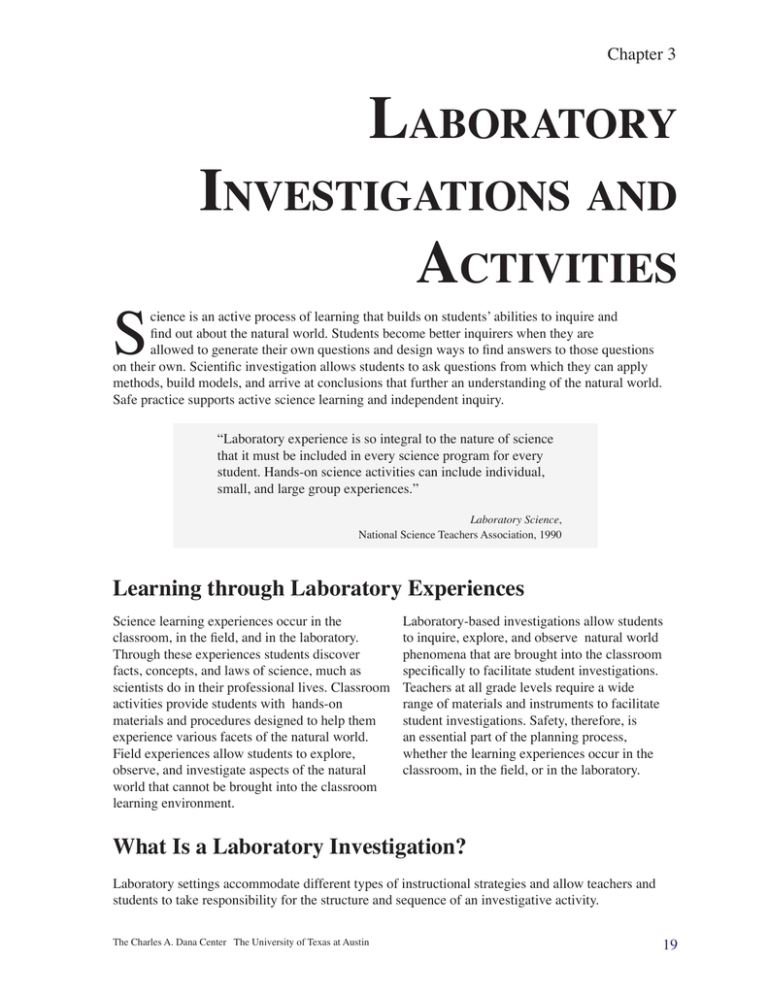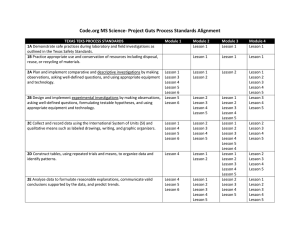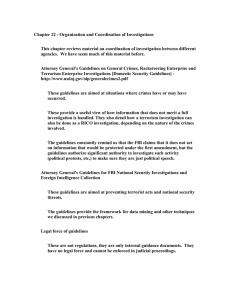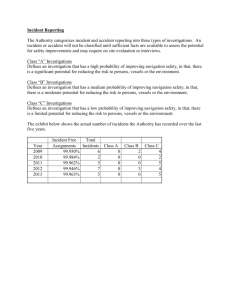LABORATORY INVESTIGATIONS AND ACTIVITIES
advertisement

Chapter 3 Laboratory S Investigations and Activities cience is an active process of learning that builds on students’ abilities to inquire and find out about the natural world. Students become better inquirers when they are allowed to generate their own questions and design ways to find answers to those questions on their own. Scientific investigation allows students to ask questions from which they can apply methods, build models, and arrive at conclusions that further an understanding of the natural world. Safe practice supports active science learning and independent inquiry. “Laboratory experience is so integral to the nature of science that it must be included in every science program for every student. Hands-on science activities can include individual, small, and large group experiences.” Laboratory Science, National Science Teachers Association, 1990 Learning through Laboratory Experiences Science learning experiences occur in the classroom, in the field, and in the laboratory. Through these experiences students discover facts, concepts, and laws of science, much as scientists do in their professional lives. Classroom activities provide students with hands-on materials and procedures designed to help them experience various facets of the natural world. Field experiences allow students to explore, observe, and investigate aspects of the natural world that cannot be brought into the classroom learning environment. Laboratory-based investigations allow students to inquire, explore, and observe natural world phenomena that are brought into the classroom specifically to facilitate student investigations. Teachers at all grade levels require a wide range of materials and instruments to facilitate student investigations. Safety, therefore, is an essential part of the planning process, whether the learning experiences occur in the classroom, in the field, or in the laboratory. What Is a Laboratory Investigation? Laboratory settings accommodate different types of instructional strategies and allow teachers and students to take responsibility for the structure and sequence of an investigative activity. The Charles A. Dana Center The University of Texas at Austin 19 Chapter 3 Examples of different types of laboratory investigations include the following. • • • Verification investigation: In this type of laboratory investigation, the student determines the cause, effect, nature, or property of a phenomenon through hands-on experience under controlled conditions. The teacher constructs a laboratory procedure, and the student follows the directions—and, if successful, confirms known results. Guided discovery: The teacher presents students with a problem, and the teacher or student develops a research design to test a hypothesis related to the problem. The teacher guides the process until the student has successfully tested the hypothesis. • Process skill practice: The objective is to teach manipulative laboratory skills. However, these skills should be integrated with science concept activities. • Process skills development: Students have opportunities to apply scientific processes to scientific investigations and problemsolving activities. • Independent study: This arrangement allows students the opportunity to explore in greater depth an area of interest not normally studied by an entire class. Planning a Safe and Effective Science Learning Environment, Texas Education Agency, 1985 Science inquiry: Students find answers for themselves and become involved in learning how to learn. 19, Texas Administrative Code Chapter 74. Curriculum Requirements Subchapter A. Required Curriculum (b) Secondary Grades 9–12 2(C) science...courses shall include at least 40% handson laboratory investigations and field work using appropriate scientific inquiry. Laboratory investigations and field work are required by the state curriculum standards, the Texas Essential Knowledge and Skills, in kindergarten through grade 12. While laboratory and field work are required in elementary and middle school science classes, the Texas Education Agency has not established the percentage of instructional time that is devoted to laboratory and field investigations at these grade levels. The National Science Teachers Association recommends that elementary students spend 80% of instructional time doing hands-on activities and 60% of instructional time for middle school. This decision is the responsibility of school districts. School boards should develop a policy that establishes the percentage of time that kindergarten– grade 8 students are to do hands-on laboratory investigations and field work. The school district’s budget should reflect support of this policy by designating appropriate funds for science equipment, materials, and proper science facilities. School districts may not charge laboratory fees for students in science classes. 20 The Charles A. Dana Center The University of Texas at Austin Chapter 3 What Qualifies as a Laboratory Investigation? A laboratory investigation consists of prelaboratory activities, the laboratory experience, and post-laboratory activities. Pre-laboratory activities introduce students to the laboratory experience. Students can gain important information about a science concept, plan strategies for conducting a successful investigation, and discuss techniques that they may use during the investigation. Demonstrations are an important method of introducing a science concept or reinforcing a student’s understanding of the concept, but demonstrations by themselves should not be considered laboratory investigations. The laboratory experience is the hands-on portion of the investigation that involves the students’ direct participation in activities such as analyzing information gathered during the laboratory experience, drawing conclusions, and producing graphs, maps, charts, or spreadsheets to assist them with communicating their findings. Computer laboratory simulations are considered laboratory investigations, but they should not replace actual hands-on experiences. As techonology has improved, the level of experience gained by computer simulations has also improved. The quality of computerassisted instruction is now an integral part of most science classes. Conclusions may lead to a need for further investigations, which students and teachers can discuss and plan during the post-laboratory activities. According to the Texas Education Agency, “demonstrations can be considered part of the 40 percent laboratory requirements.” School districts should develop policies on the types of science activities that will ensure quality science programs that meet the needs of their students. The following summary represents what students are expected to know and be able to do as mandated in the Texas Essential Knowledge and Skills in Science. Laboratory Experiences in Kindergarten–Grade 2 Laboratory-based experiences begin in the early grades when students ask questions, plan and conduct simple descriptive investigations, extend their senses through the use of tools, construct reasonable explanations, and communicate their findings. Science experiences in these early grades allow students to inquire, explore, and observe phenomena that are brought into the classroom specifically to stimulate student investigations. Teachers know that students in kindergarten through grade 2 become better inquirers when they are allowed to generate their own questions and design ways to answer those questions on their own by actively doing science. Students should follow home and school safety procedures when participating in classroom investigations. They should demonstrate safe practices while learning to use and conserve resources and materials. “Elementary school students learn science best when they are involved in first-hand exploration and investigation and inquiry/process skills are nurtured.” Elementary School Science, National Science Teachers Association, 2002 The Charles A. Dana Center The University of Texas at Austin 21 Chapter 3 Laboratory Experiences in Grades 3–5 Laboratory-based experiences in kindergarten through grade 2 required the students to plan and implement descriptive investigations by asking well-defined questions, formulating hypotheses, and selecting the equipment and materials needed to conduct the investigations. Students in grades 3­–5 can generate their own questions and design ways to find answers to those questions on their own. They can collect information by observing and taking measurements, and analyze and interpret that information to develop reasonable explanations about the results. Students should be able to communicate valid conclusions and, when possible, incorporate graphs, tables, maps, and charts to organize and evaluate information. When conducting field and laboratory investigations, students should follow home and school safety procedures as well as environmentally appropriate and ethical practices. Students should demonstrate safety practices during the field and laboratory investigations and make wise choices in the use and conservation of resources. Laboratory Experiences in Grades 6–8 Laboratory-based experiences in the earlier grades allowed students to inquire, explore, and observe things that were brought into the classroom specifically to stimulate student investigations. Middle-grade students will become better inquirers when they are allowed even more freedom to generate their own questions and design ways to find answers to those questions on their own. Students in grades 6–8 should have the freedom to select and use equipment and technology to implement investigative procedures. By grade 8, students should be able to plan and implement descriptive and experimental investigative procedures, collect data, organize, analyze, evaluate, make inferences, and predict trends in evidence. They should be able to communicate valid conclusions effectively and use tools to construct graphs, tables, maps, and charts. Students should demonstrate safe practices that are environmentally appropriate and ethical as they conduct laboratory investigations and do fieldwork. Laboratory Experiences in Grades 9–12 High school teachers should expect students to be better science learners when they are allowed the freedom to generate their own questions and design ways to find answers to those questions on their own. Students in ninth-grade science should already have had numerous field- and laboratory-based science experiences from kindergarten through grade 8, and they will have used a wide range of science materials and instruments. 22 By grade 9, students should be able to demonstrate many of the new science concepts they are learning. They should be able to plan and implement descriptive and experimental investigative procedures in which they select equipment and technology to facilitate their investigations. Specialized equipment and procedures facilitate students’ conceptual understanding of complex concepts, many of which require special precautions to assure student safety in the laboratory. The Charles A. Dana Center The University of Texas at Austin Chapter 3 Laboratory Management Techniques Classroom management techniques maximize and reinforce proper behavior and safety in the science laboratory. Essential knowledge, concept mastery, and process skill development have high priority in the science laboratory and depend on effective strategies for maximizing learning. Fortunately, the techniques that maximize learning also promote safety. The following represents a list of recommended laboratory management techniques. Table 5 Laboratory Management Techniques 1. Maintain fair and consistent classroom discipline to prevent unsafe conditions from being created during laboratory investigations. 2. Establish routine procedures for conducting a laboratory investigation that promote an orderly and safe environment. Ask different students in each laboratory group to • obtain materials from a supply area, • return materials at the completion of a laboratory investigation, and • record data, if class data are needed. 3. Explain and post the expectations for orderly conduct in the classroom, laboratory, and field. Teachers should always model appropriate classroom, laboratory, and field procedures. 4. Explain and post safety rules for the classroom, laboratory, and field. Students and parents should complete and return a signed safety contract before students begin investigations. 5. Explain the consequences of unsafe behavior. 6. Before each laboratory investigation, review the safety rules for using laboratory equipment and facilities. 7. Prior to the investigation, arrange for the proper disposal of wastes. 8. Keep up with current information on safety and class procedures, and practice those procedures consistently. The Charles A. Dana Center The University of Texas at Austin 9. Examine laboratory investigations and equipment for appropriateness and safety. 10. Review with students the procedures for using the laboratory. Discuss safety rules and precautions before the investigation begins. 11. Promote a positive attitude. Students should not fear doing experiments, using reagents, or using equipment, but should have a positive attitude toward safe laboratory procedures. 12. Adjust procedures for students with emotional, physical, or educational problems to capitalize on the contributions they are able to make. 13. When a substitute teacher is in charge, create an alternate lesson plan that does not involve laboratory work. 14. Monitor continuously for maximized learning and safe conditions. 15. Plan post-lab activities. 16. Clean the work areas thoroughly and regularly. 17. Develop procedures to be followed in case of an accident. 18. Establish procedures for asking students to leave the laboratory when they demonstrate unacceptable behavior. Paraphrased from Secondary Science Safety, by J. G. Gerlovich, T. F. Gerard, B. Shriver, G. E. Downs, and L. C. Flinn, Jr., and from Science Laboratory Techniques, by R. B. Bartholomew and F. E. Crawley, 1985. 23 Chapter 3 Evaluating Safety in Laboratory Investigations Laboratory investigations and experiments are handed down from one teacher to another, given away at conferences, downloaded from the Internet, and found in journals. But how does the teacher know that the laboratory investigation is safe for students to use? To evaluate how safe an investigation is, consider these guidelines before allowing students to conduct an unfamiliar investigation. Remember, the teacher should always complete the investigation before approving it for student use. Table 6 What Can Be Done in Advance? • Do not assume that investigations published in laboratory manuals or journals, or acquired from other teachers, are safe. • Know the hazards of predicted products that may form during the chemical reactions in the investigation. • The correct amounts of substances and concentrations of solutions should be clearly stated in the directions. • Always read and check new investigations carefully. • Appropriate safety symbols should be present in the investigation to alert students to a precaution against a hazard. • Substances with a high hazard rating should not be used in science labs. Substitute safer compounds for the hazardous substance. • The investigation should inquire into, investigate, illustrate, or analyze a scientific concept or principle in a safe manner or method. • Check the electrical equipment for proper grounding, frayed wires, and safe connections. • All precautions must be thoroughly discussed in the pre-lab session with the students. • The students should be aware of what to do with the products that are formed and any remaining materials. • The investigation must be clearly written so that students understand exactly what to do and how to carry out the activity. • • • 24 Check the equipment or setup to be used and the glassware for proper assembly and cracks. Know all the actions and reactions that should occur between the chemicals to be used, and investigate unexpected reactions that might occur. Know the hazards of all substances used in the activity. Material Safety Data Sheets (MSDS) and other safety references should be consulted. Science Laboratory Safety and Chemical Waste Disposal for Texas Science Teachers, Texas Education Agency, 1990 The Charles A. Dana Center The University of Texas at Austin Chapter 3 Responding to a Laboratory Accident Being prepared for accidents will help decrease the possibility of an accident becoming more severe or of other injuries occurring. In the event of an accident, action must be taken quickly to minimize the effects of the accident. It is strongly recommended that teachers receive professional training in cardiopulmonary resuscitation (CPR), first aid, abdominal thrust (Heimlich maneuver), and other emergency procedures. Planning for an emergency should involve the entire organization within your school: administrators, maintenance staff, custodial staff, office staff, nurse, teachers, students, and parents. Every area and event should be included in the planning, including the school building and grounds, field trips, etc. Common Emergencies Possible emergencies that teachers may respond to include . . . • • • • • • • • small to moderate fires chemical reactions that result in an explosion serious burns resulting from exothermic reactions serious chemical burns ingestion of hazardous chemicals electrical shocks from equipment chemical spills resulting from broken containers minor to serious cuts If an Accident Occurs 1. Attend to the injured person(s) immediately. 4. If the injury is the result of chemicals . . . 2. Administer first aid in the laboratory to . . . • • stop the flow of blood in the case of a cut, and wash off any caustic chemicals on the body or in the eyes. Special Note: Teachers should wear protective gloves before handling victims who are bleeding. 3. If the injury is a cut or an abrasion . . . • wash the injured area thoroughly. • place a compress on the wound to stop the flow of blood. • replace the compress with a sterile bandage if the injury is minor. • accompany the student to the nurse’s office if the injury is moderate or severe. • follow the proper procedures to clean up blood. The Charles A. Dana Center The University of Texas at Austin • • • • rush the injured person to the safety shower (safety showers should be within 10 seconds of any student— approximately 50 feet away). immediately drench the entire area with a continuous flow of water for 15 minutes. send a student to alert the school’s nurse or to get another teacher. use a spill kit to contain and remove the chemicals. 5. If foreign materials or chemicals have entered the eye . . . • rush the student to the dual eyewash station (eye/face washes should be within 10 seconds of any student). 25 Chapter 3 • remember, the student will have difficulty seeing, so guide him or her to the eye/face wash station. • rinse the open eyes with a continuous stream of tepid water (60–90oF) for 15 minutes. • send a student to alert the school’s nurse or another teacher. 6. If the injury is the result of electrical shock . . . • separate the person from the electrical source carefully. Use the master control switch. • call for emergency medical aid immediately. • check for breathing and pulse immediately. • start CPR if necessary. • check for entrance and exit burns. Treat burns as you would a thermal burn. • there may be two burns present—one where the power entered the body and the other where it exited. Some burns are large and below the skin. • keep the injured person warm, quiet, and lying down. • the injured person may stop breathing after being shocked by high-frequency electrical currents or being struck by lightning. • the injured person may be unconscious, dazed, weak, or confused, with an irregular pulse. 7. The nurse should assume responsibility for providing help at this point by . . . • • • administering additional first aid, contacting the parents, and pursuing additional treatment if necessary (information is on students’ emergency health cards). 8. If the nurse is not available, the teacher is obligated to follow through with accident procedures to protect the student from further injury. • • The teacher or nurse should call the student’s parents to advise them of the severity of the accident and to ask their permission to proceed with treatment as needed. If the parents cannot be reached, the teacher must act in accordance with the situation. The student’s emergency health card gives permission for emergency care to be administered. The teacher should call a physician and, upon the physician’s advice, seek treatment for the injured student. 9. After the injured person has been cared for and any chemical spill contained, the teacher needs to fill out an accident report for their own protection even if it is not required by the school district. Regardless of how good the science facilities are, how well we are trained on safety, how much emphasis we place on safe procedures— accidents are going to happen. How well we respond to accidents depends on how well we are prepared. 26 The Charles A. Dana Center The University of Texas at Austin Chapter 3 Emergency Response System School personnel should organize an emergency response system at the beginning of the school year before laboratory investigations and activities begin. This system should include clearly defined roles and responsibilities for an Emergency Response Team (ERT). The ERT should be prepared to move quickly and effectively when responding to accidents in order to reduce injury to a student or teacher, and damage to property in a science classroom. Emergency Response Team An emergency response team composed of central office personnel, teachers, and students should be trained to respond to an emergency in a science laboratory or classroom. In addition, team members should take preventative measures to ensure safety in the laboratory by regularly checking equipment and facilities. If an accident should occur, each member of the team must be able to respond quickly and to perform his or her role effectively to assist an injured person and reduce damage to property. Emergency Preparedness The following list outlines some responsibilities that an emergency response team might perform. This does not represent a complete list but should form the basis of emergency preparedness. • Practice regular fire and evacuation drills. • Make sure that safety equipment is accessible and operating correctly. • Inspect first-aid kits and chemical spill kits. • Monitor safety equipment regularly. • Compile and maintain a current file of Material Safety Data Sheets (MSDS). • Practice responding to simulated accidents and emergencies. • Identify which chemical spills to respond to and which ones a professional HazMat (Hazardous Materials) team should handle. • Attend professional development on first aid, including CPR and abdominal thrust procedures (Heimlich maneuver). • Document information about accidents, and maintain these records for a minimum of two years. An example of how an emergency response team could respond to a fire emergency follows (Figure 4). The Charles A. Dana Center The University of Texas at Austin 27 Chapter 3 Emergency Response Team Response to a Fire Emergency Figure 4 28 The Charles A. Dana Center The University of Texas at Austin Chapter 3 Causes of Laboratory Accidents To prevent accidents, it is necessary to identify the causes of accidents. The school’s, teacher’s, and students’ actions (or lack thereof) can contribute to many laboratory accidents. The following information was adapted from Science Laboratory Safety and Chemical Waste Disposal for Texas Science Teachers, Texas Education Agency, 1990. When the School or the Teacher Is at Fault 1. Failure to thoroughly plan and conduct a safe activity 3. Unsafe activity design, chemicals, or equipment • • • • • • • failure to incorporate safety into the activity use of unnecessary hazardous chemicals following unsafe procedures and methods failure to plan for disposal of waste or hazardous chemicals lack of teaching experience and safety training failure to use and maintain discipline failure to enforce safety rules 2. Failure of the teacher to give adequate, clear instructions or perform thorough inspections of equipment • • • incorrect instructions given to students, or students did not understand the instructions before beginning the activity failure to inspect equipment failure to monitor students during the activity • • • unsafe or improper planning of the activity improper or poorly designed equipment failure to check to see if chemicals were suitable or safe to use 4. Failure to provide safe laboratory work areas • • • • • inadequate facilities: poor lighting and ventilation inadequate or inappropriate work space only one exit in laboratory improper storage area inadequate maintenance and poor housekeeping 5. Proper safety equipment not provided or maintained • • • • failure to provide fire extinguishers failure to maintain safety equipment failure to provide safe equipment and materials lack of safety equipment: goggles, lab aprons, fume hoods, showers, eye/face wash stations “Teachers bring into the room much larger quantities of flammable materials for demonstrations than they really need to do it,” . . . said [James A. Kaufman, director of the Laboratory Safety Institute, a Natick, Mass., nonprofit that publishes classroomsafety guidelines]. If an accident occurs, he pointed out, they have “100 times as much [chemical] getting involved in whatever the problem is.” David J. Hoff “Science–Lab Safety Upgraded After Mishaps.” Education Week, 2003. The Charles A. Dana Center The University of Texas at Austin 29 Chapter 3 When the Student Is at Fault 1. Failure to follow instructions and use safe practices • • • • • • • • • safety rules not followed precautions and procedures not followed failure to understand what is to be done lack of knowledge of the hazards doing unauthorized experiments working without approval being disorderly failure to have equipment approved by the teacher failure to follow teacher’s instructions 2. Failure to use personal protective equipment • • • • failure to wear eye protection improper clothing and shoes failure to use fume hoods improper use of protective equipment 3. Improper use of equipment or chemicals • • • • • failure to follow precautions incorrect use of chemicals use of wrong chemicals failure to follow instructions using an instrument failure to monitor experiment or equipment in operation 4. Physical condition of the student • • • • student was ill student was fatigued—not attentive or alert student was under the influence of alcohol or other drugs student had poor manual dexterity or skills 5. Mental attitude and knowledge • • • • • • • • • failure to understand the experiment lack of knowledge needed to do the experiment lack of good judgment too rushed—resulted in clumsy work habits tried to use a shortcut that was hazardous inability to work cooperatively with other students tried procedures that were not safe indulged in uncontrolled anger or impulsive actions failure to remain calm and in control Other Factors 1. Equipment or materials with unknown defects 30 • • • • chemicals contaminated chemical mislabeled equipment with unknown defect unknown tampering with equipment before use 2. Other influences • • • weather—electrical surges or other weather damage failure of local power plants vandalism of equipment The Charles A. Dana Center The University of Texas at Austin




